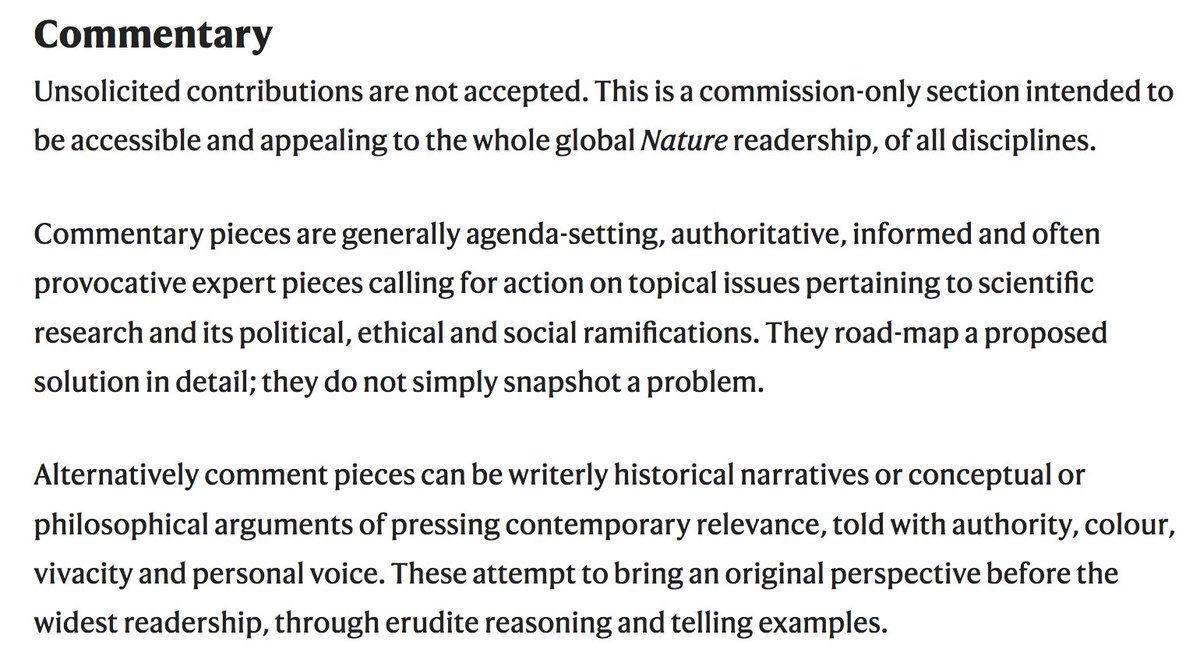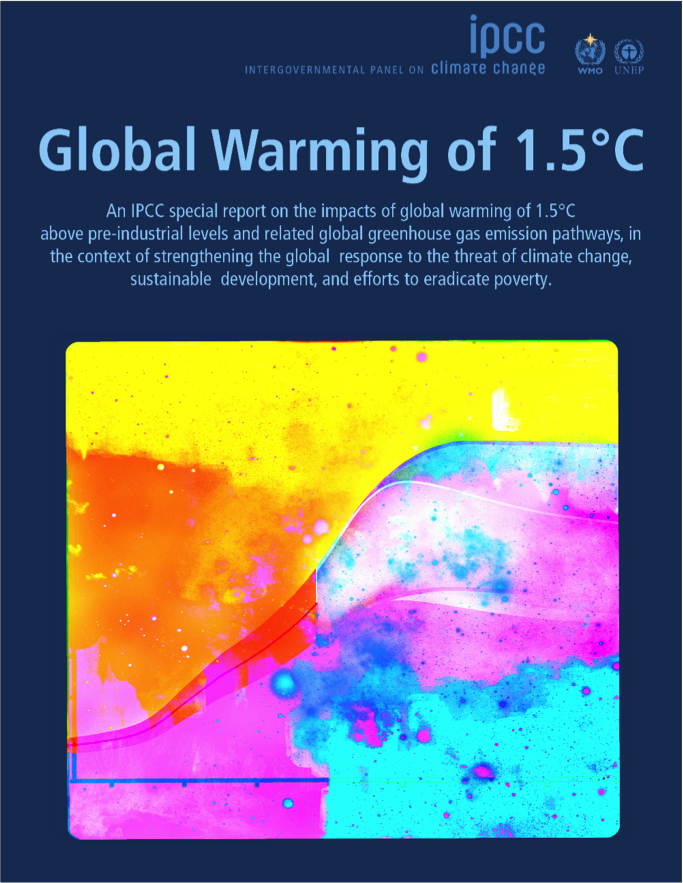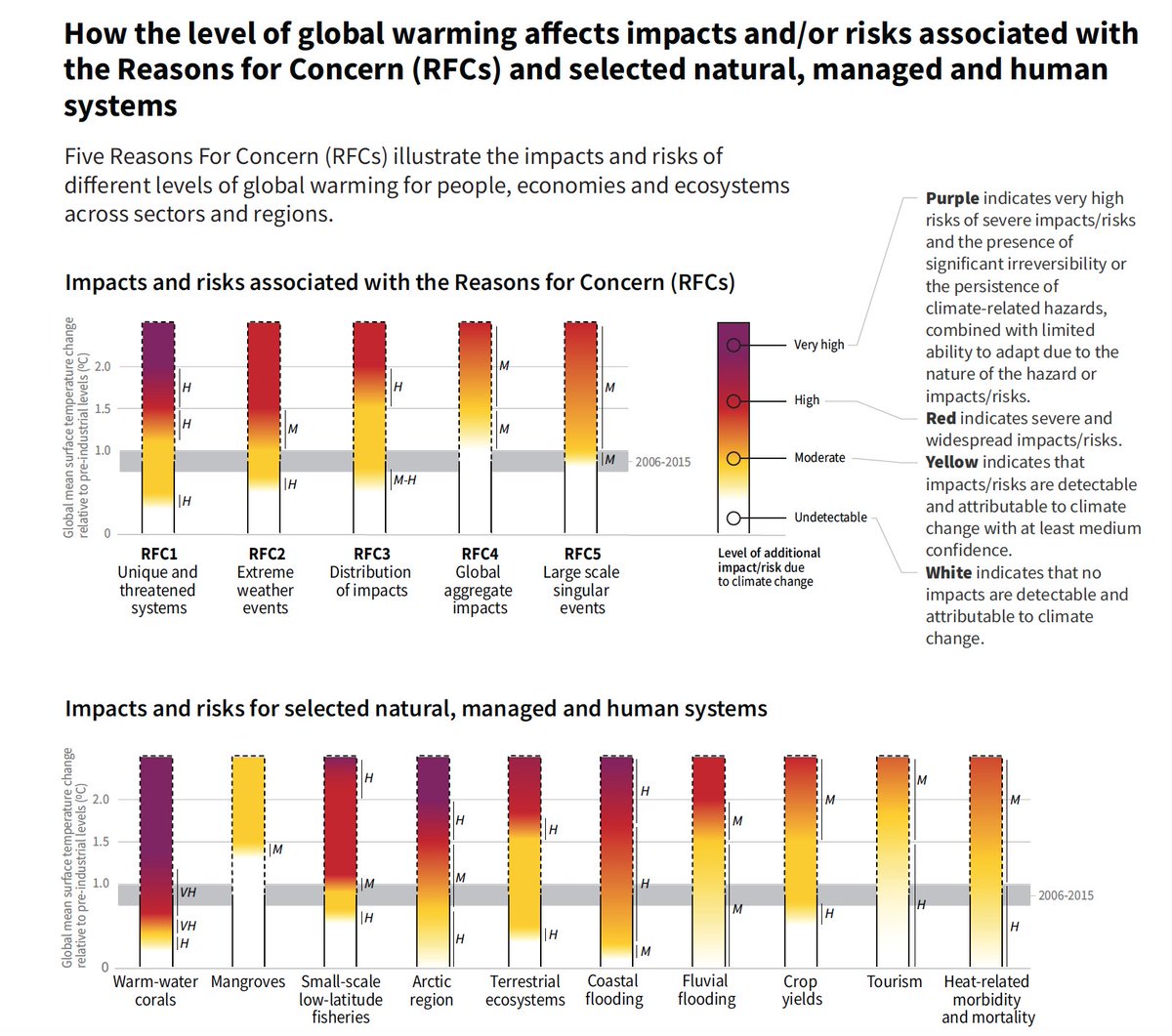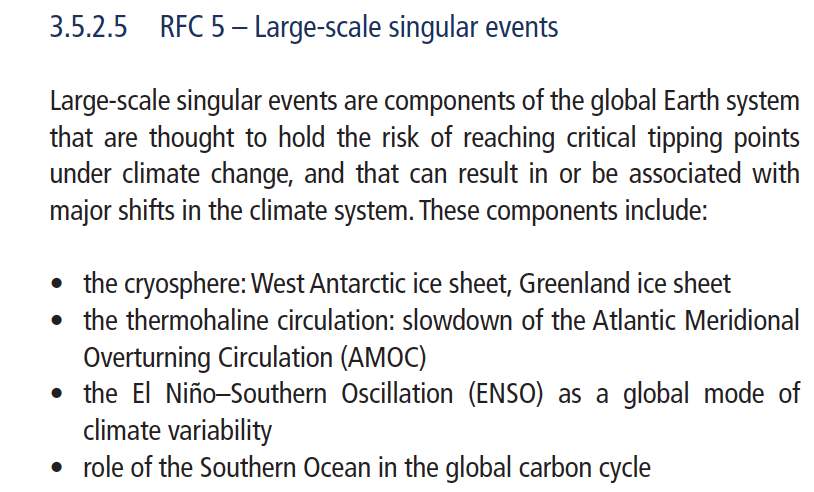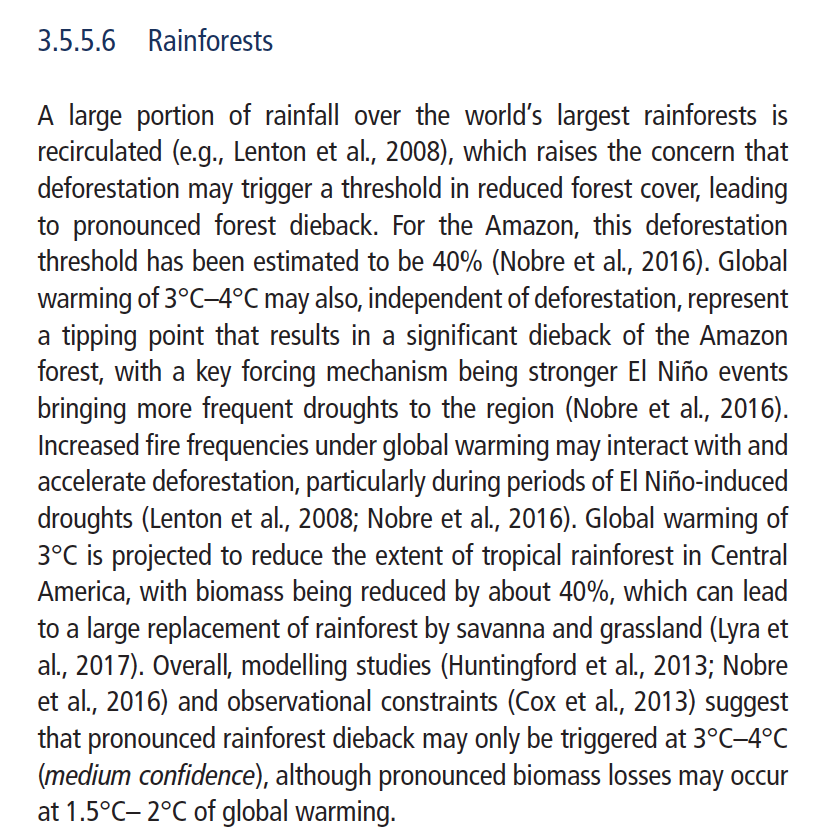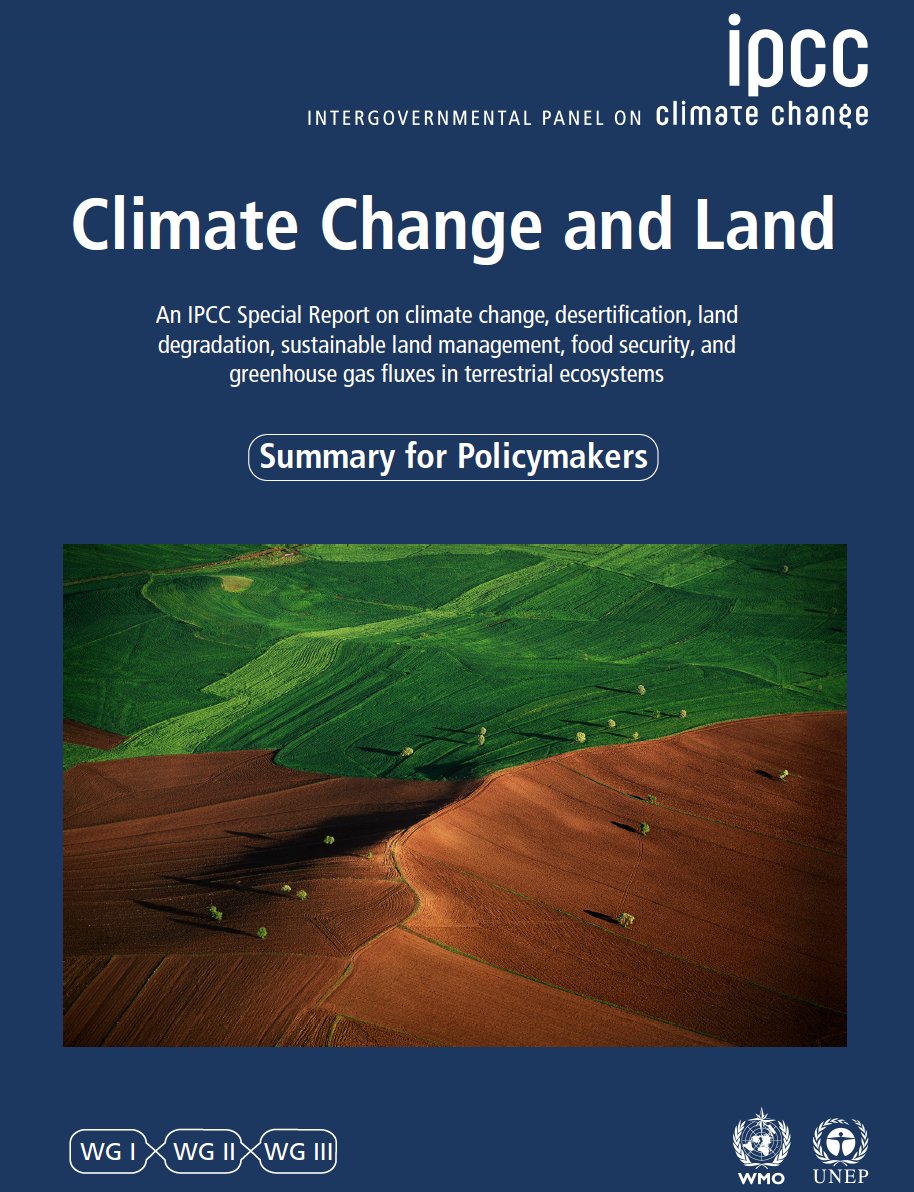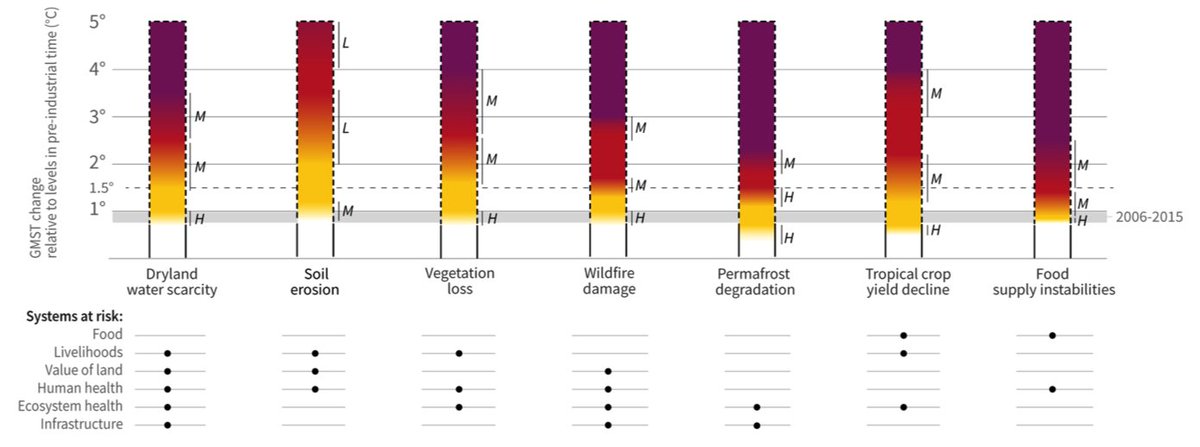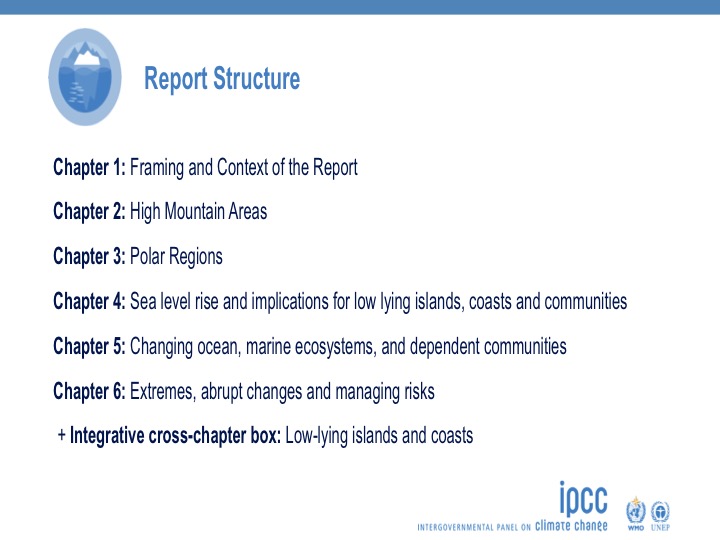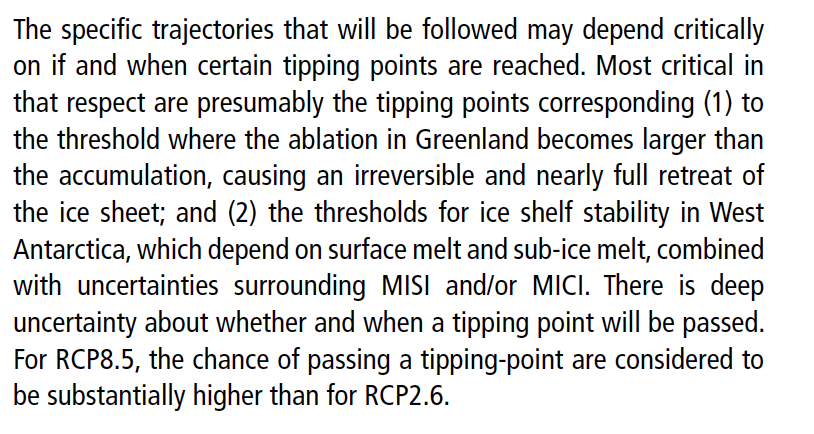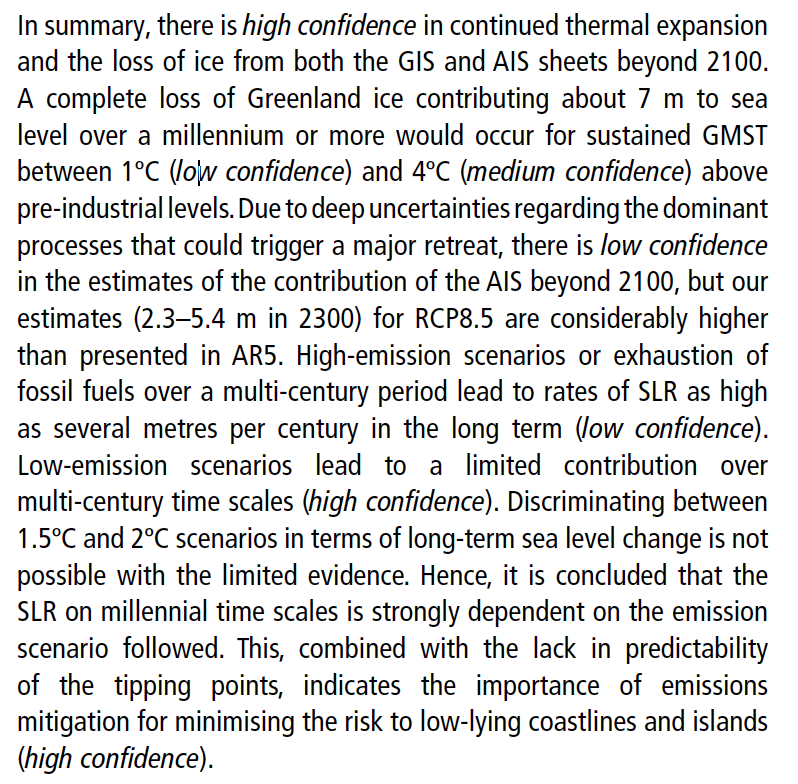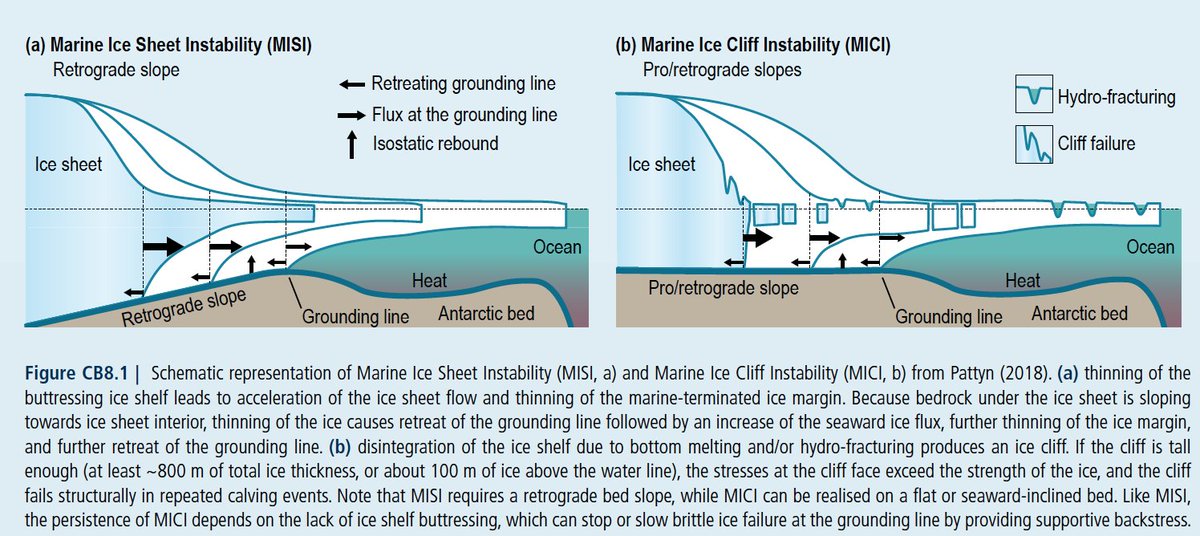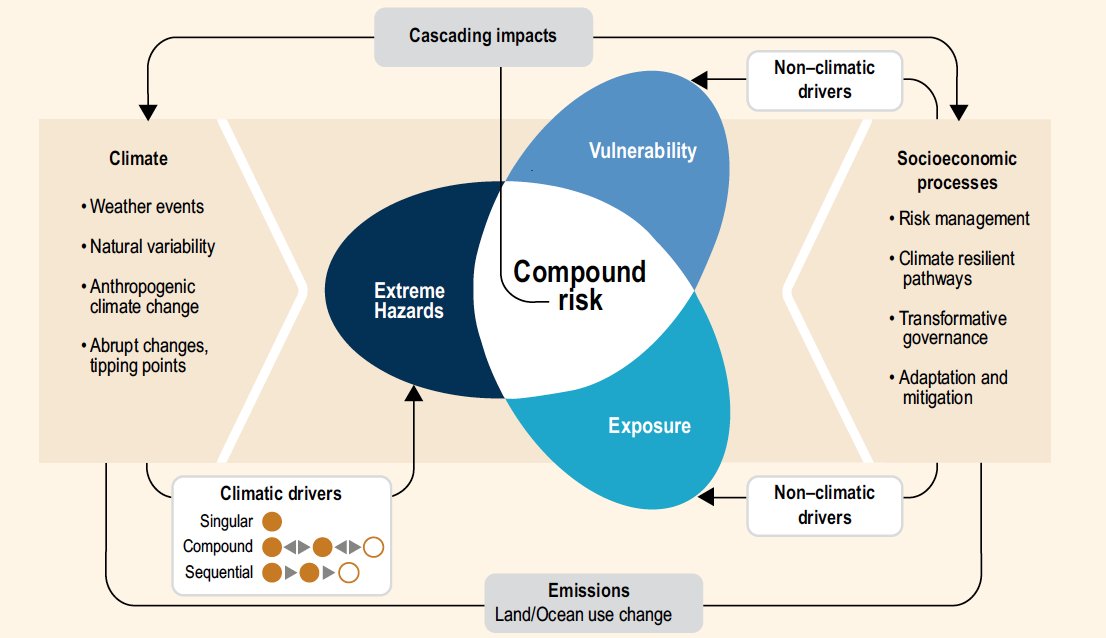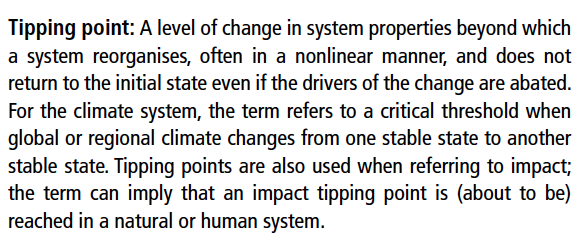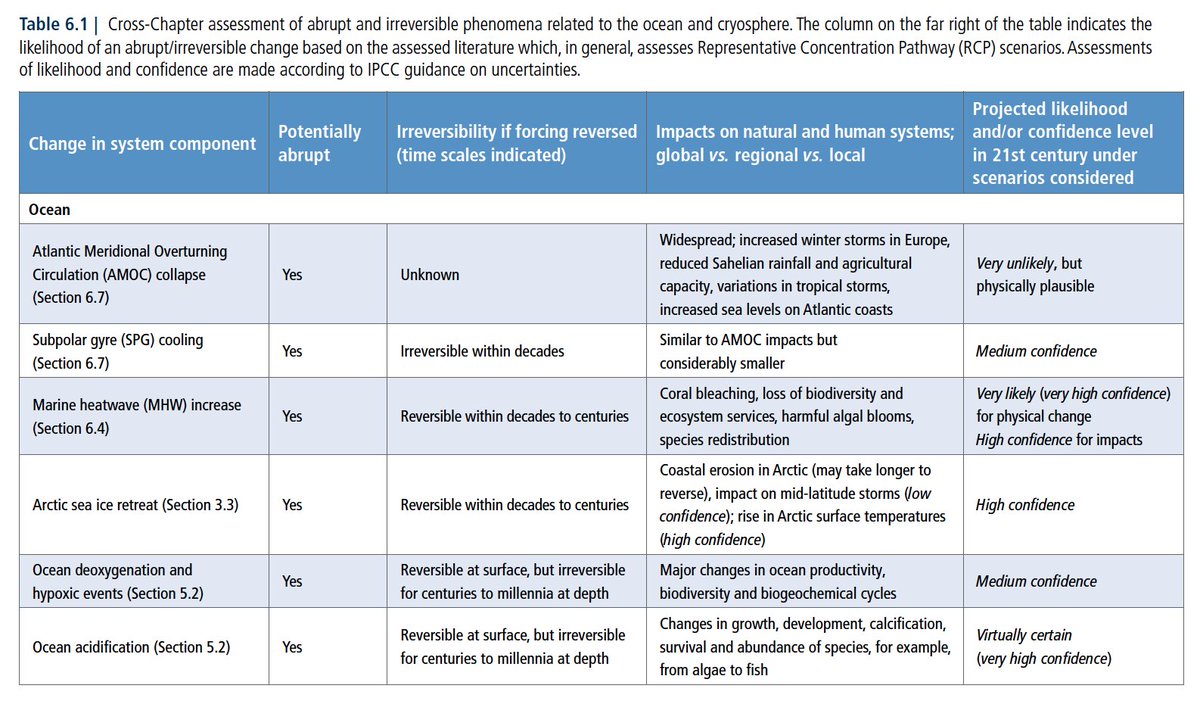THREAD – CLIMATE TIPPING POINTS IN @IPCC_CH 2018 AND 2019 SPECIAL REPORTS
There has recently been a very broad interest in the issue of climate tipping points, following the media coverage of this commentary in @NatureNews : http://www.nature.com/articles/d41586-019-03595-0">https://www.nature.com/articles/...
The recent comment in Nature cited two or three recent IPCC Special Reports.
Its figure, citing « source, IPCC » is an incorrect representation of the risk assessment in IPCC reports, as shown here for AR5 and #SR15. @NatureNews, could your figure be updated to correctly reflect the risk thresholds as assessed in IPCC reports?
But what is the assessment in these recent IPCC Special Reports #SR15 #SRCCL and #SROCC on « climate tipping points » ?
Let’s first have a look at IPCC #SR15, which focused on impacts and risks for low levels of global warming (mostly between today’s 1°C, and 1.5°C and 2°C warmer worlds).
The Summary for Policy Makers provides an update of the assessment of impacts and risks associated with « large scale singular events », defined as relatively large, abrupt and sometimes irreversible changes in systems that are caused by global warming.
AR5 assessed that the risks associated with these events become moderate between 0.6°C and 1.6°C above pre-industrial levels, and that risk was expected to become high between 1.6°C and 4.6°C based on the potential for irreversible sea level rise from land-based ice sheets
(with low to medium confidence)
The SR15 assessment is that moderate risk
is now located at 1°C of global warming and high risk is
located at 2.5°C of global warming, because of new
observations and models of the West Antarctic ice sheet (with medium confidence).
is now located at 1°C of global warming and high risk is
located at 2.5°C of global warming, because of new
observations and models of the West Antarctic ice sheet (with medium confidence).
There is of course a detailed assessment in the underlying chapter, traceable to the evidence and agreement in the scientific literature
https://www.ipcc.ch/sr15/chapter/chapter-3/">https://www.ipcc.ch/sr15/chap...
https://www.ipcc.ch/sr15/chapter/chapter-3/">https://www.ipcc.ch/sr15/chap...
For ice sheets, the conclusion : the temperature range of 1.5°C–2°C may be regarded as representing moderate risk, in that it may trigger marine ice sheet instability in
Antarctica or irreversible loss of the Greenland ice sheet
Antarctica or irreversible loss of the Greenland ice sheet
and it may be associated with sea level rise by as much as 1–2 m over a period of two centuries.
For the Atlantic Meridional Overturning Circulation :
- it is more likely than not that the AMOC has been weakening in recent decades,
- there is limited evidence linking the recent weakening of the AMOC to anthropogenic warming
- it is more likely than not that the AMOC has been weakening in recent decades,
- there is limited evidence linking the recent weakening of the AMOC to anthropogenic warming
- it is very likely that the AMOC will weaken over the 21st century
- there is no evidence indicating significantly different amplitudes of AMOC weakening for
1.5°C versus 2°C of global warming, or of a shutdown of the AMOC at these global temperature thresholds.
- there is no evidence indicating significantly different amplitudes of AMOC weakening for
1.5°C versus 2°C of global warming, or of a shutdown of the AMOC at these global temperature thresholds.
Associated risks are classified as low to moderate
No clear conclusion for the role of the Southern Ocean in the global carbon sink in this range of warming.
The evidence for an increased frequency of extreme El Nino events with the level of global warming leads to indicate high risk even for 1.5°C.
There is also in #SR15 an assessment of regional tipping points, looking whether there is or not evidence for bifurcation / irreversibility / tipping points.
No evidence of a tipping point for Arctic sea ice itself (different of course for related ecosystems or species).
No evidence of a tipping point for Arctic sea ice itself (different of course for related ecosystems or species).
There is a short assessment related to the rainforests, under pressure from both deforestation and climate change.
There is limited reference to tipping points in this report, but irreversibility of land degradation including desertification is of course part of the assessment.
The report highlights specific ecosystems particularly vulnerable to irreversibility (which cannot be restored to an earlier state), due to both pressure on land and climate change :
- peatlands (difficulties of rewetting to original states),
- dryland grazing systems are vulnerable to tipping points when ground cover falls below 50%, after which productivity falls, infiltration declines, and erosion increases
The assessment of risks related to land processes includes irreversible loss in land ecosystem functions and services required for food, health, habitable
settlements and production as a function of the level of global warming.
settlements and production as a function of the level of global warming.
Irreversible forms of land degradation (e.g. loss of topsoil, severe gully erosion) can lead to the complete loss of land productivity.
Potential limits to adaptation exist if land degradation becomes severe and irreversible: coastal erosion where land disappears, collapsing livelihoods due to thawing of permafrost, and extreme forms of soil erosion (e.g., landslides, gully erosion leading to badlands).
The long term irrigation practice from groundwater may also cause severe combination of potential side effects and consequently irreversible results.
The combined pressure of water limitations and frequent fire can lead to transition from closed forest to savannah or grassland: if fire is too frequent trees do not reach reproductive maturity and post-fire regeneration will fail;
likewise, reduced rainfall / increased drought prevents successful forest regeneration
The report briefly mentions another dimension of irreversibility which is linked to the loss of cultural heritage.
More with the full report, available here :
https://www.ipcc.ch/srccl/ ">https://www.ipcc.ch/srccl/&qu...
https://www.ipcc.ch/srccl/ ">https://www.ipcc.ch/srccl/&qu...
There are tens of occurrences of references to "tipping points" in this report, starting from the framing chapter.
Chapter 1 introduces the notion of non linearity and thresholds related to the ocean and cryosphere.
"Potential ocean and cryosphere tipping elements form part of the scientific case for efforts to limit climate warming to well below 2°C (IPCC, 2018)".
This #SROCC chapter 1 also introduces the notion of "deep uncertainty", and provides three examples : permafrost carbon and greenhouse gas emissions; Antarctic ice sheet and sea level rise; compound risk and cascading impacts
Chapter 4 on sea level rise has a detailed assessment of the state of knowledge related to long term ice sheet changes. I just stress the conclusion of its section on long-term scenarios, beyond 2100.
There is also a full cross-chapter box on marine ice sheet instability (Cross-Chapter Box 8 in Chapter 3)
About a third of the Antarctic Ice Sheet (AIS) is ‘marine ice sheet’, i.e., rests on bedrock below sea level (Figure 4.5), with most of the ice sheet margin terminating directly in the ocean. These features make the ice sheet vulnerable to dynamical instabilities.
The future dynamic response of the Antarctic ice sheet oo warming will largely be determined by changes in ice shelves, because their thinning or collapse will reduce their buttressing capacity, leading to an acceleration of the grounded ice and to thinning of the ice margin.
Since AR5, there is growing observational and modelling evidence that accelerated retreat may be underway in
several major Amundsen Sea outlets, including Thwaites, Pine Island, Smith, and Kohler glaciers
several major Amundsen Sea outlets, including Thwaites, Pine Island, Smith, and Kohler glaciers
One of the largest outlets of the East Antarctic Ice Sheet (EAIS), Totten glacier, has also been retreating and thinning in recent decades
Overall, this assessment finds that unstable retreat and thinning of some Antarctic glaciers, and to a lesser extent Greenland outlet glaciers, may be underway
However, the timescale and future rate of these processes is not well known, casting deep uncertainty on
projections of the sea level contributions from the Antarctic ice sheet.
projections of the sea level contributions from the Antarctic ice sheet.
Let& #39;s now move to #SROCC chapter 6, which is has a strong focus on abrupt change (here in the sense of either aspects of the physical system or in terms of irreversibility of impacts on ecosystems or human systems).
Let& #39;s focus on the conclusion of this assessment for the Atlantic Meridional Overturning Circulation (AMOC).
Observations, both in situ (2004–2017) and based on sea
surface temperature reconstructions, indicate that the Atlantic Meridional Overturning Circulation (AMOC) has weakened relative to 1850–1900
surface temperature reconstructions, indicate that the Atlantic Meridional Overturning Circulation (AMOC) has weakened relative to 1850–1900
There is insufficient data to quantify the magnitude of the weakening, or to properly attribute it to anthropogenic forcing due to the limited length of the observational record.
Although attribution is currently not possible, CMIP5 model simulations of the period 1850–2015, on average, exhibit a weakening AMOC when driven by anthropogenic forcing.
The AMOC will very likely weaken over the 21st century (high confidence), although a collapse is very unlikely (medium confidence). Nevertheless, a substantial weakening of the AMOC remains a physically plausible scenario.
Such a weakening would strongly impact natural and human systems, leading to a decrease in marine productivity in the North Atlantic, more winter storms in Europe, a reduction in Sahelian and South Asian summer
rainfall,
rainfall,
a decrease in the number of tropical cyclones in the Atlantic, and an increase in regional sea level around the Atlantic especially along the northeast coast of North America (medium confidence). Such impacts would be
superimposed on the global warming signal.
superimposed on the global warming signal.
By 2300, an AMOC collapse is as likely as not for high emission pathways and very unlikely for lower ones, highlighting that an AMOC collapse can be avoided in the long term by CO2 mitigation (medium confidence).
Nevertheless, the human impact of these physical changes have not been sufficiently quantified and
there are considerable knowledge gaps in adaptation responses to a substantial AMOC weakening.
there are considerable knowledge gaps in adaptation responses to a substantial AMOC weakening.
These findings related to potential tipping points, abrupt change and irreversibility are reflected in the #SROCC Summary for Policy Makers.
For instance, for ice sheets :
Acceleration of ice flow and retreat in Antarctica, which has the potential to lead to sea level rise of several metres within a few centuries, is observed in the Amundsen Sea Embayment of West Antarctica and in Wilkes Land, East Antarctica (very high confidence).
These changes may be the onset of an irreversible ice
sheet instability.
sheet instability.
Uncertainty related to the onset of ice sheet instability arises from limited observations, inadequate model representation of ice sheet processes, and limited understanding of the complex interactions between the
atmosphere, ocean and the ice sheet
atmosphere, ocean and the ice sheet
Processes controlling the timing of future ice-shelf loss and the extent of ice sheet instabilities could increase Antarctica’s contribution to sea level rise to values substantially higher than the likely range on century and longer time-scales (low confidence).
Considering the consequences of sea level rise that
a collapse of parts of the Antarctic Ice Sheet entails, this high impact risk merits attention
a collapse of parts of the Antarctic Ice Sheet entails, this high impact risk merits attention
The sea level rise range that needs to be considered for planning and implementing coastal responses depends on the risk tolerance of stakeholders.
Stakeholders with higher risk tolerance (e.g., those planning for investments that can be very easily
adapted to unforeseen conditions) often prefer to use the likely range of projections,
adapted to unforeseen conditions) often prefer to use the likely range of projections,
while stakeholders with a lower risk tolerance (e.g., those deciding on critical infrastructure) also consider global and local mean sea level above the upper end of the likely range (globally 1.1 m under RCP8.5 by 2100)
and from methods characterised by lower confidence eg from expert elicitation.
The assessment of AMOC changes is also reported in the Summary for Policy Makers.
The text of the Summary for Policy Makers therefore includes a description of "what if low probability, high impacts events unfold".
The #SROCC assessment highlights the current stage of knowlege and its limits, complementing the assessment of #SR15 for higher levels of warming (and longer timescales) based on CMIP5 projections and recent developments from the available literature.
More information in the full report, here : https://www.ipcc.ch/report/srocc/
-">https://www.ipcc.ch/report/sr... END -
-">https://www.ipcc.ch/report/sr... END -

 Read on Twitter
Read on Twitter